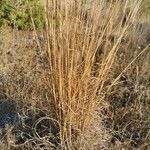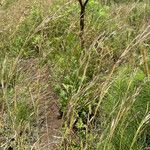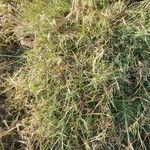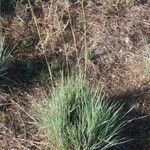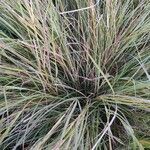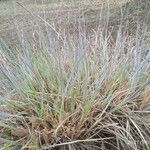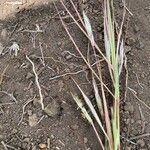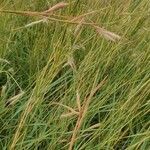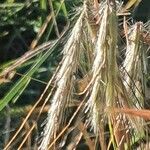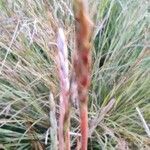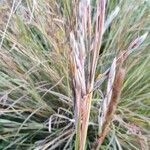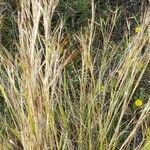Wiry, tufted perennial, 300-800 mm high; rhizomatous; culms slender; fresh shoots not aromatic. Leaf blade 20-150 x 1-2(-4)mm; ligule an unfringed membrane. Inflorescence of 2-10 raceme pairs, racemes enclosed by spatheoles, crowded into large, leafy, false panicle, panicle scanty; raceme pairs with 8-14 awns; raceme bases terete, unequal; racemes never deflexed; spikelets in pairs, one sessile, the other pedicelled, with 1 homogamous pair at base of upper racemes or absent. Sessile spikelets 4.0-6.5 mm long, dorsiventrally compressed, yellowish green to violet, white-villous. Florets 2; lower floret sterile, reduced to a lemma, awnless; upper floret bisexual, lemma less firm than glumes towards base, hyaline, 2-lobed, awns 10-35 mm long, with hairs up to 0.3 mm long; callus acute, tip visible on apex of internode. Pedicellate spikelets 3-7 mm long, awnless. Flowering time Sept.-June.
False panicle up to 30 cm long, typically scanty with only 2–10 raceme-pairs but sometimes a little fuller with more raceme-pairs; spatheoles 3–8 cm long, linear-lanceolate, at length reddish; peduncles about as long as the spatheoles, glabrous or with white bulbous-based hairs above; racemes 2–4 cm long, 8–13(16)-awned per pair, white-villous, terminally exserted, never deflexed; raceme-bases unequal, the superior 2.5–5 mm long, filiform, glabrous or more usually pubescent to hirsute, with or without a white beard at the foot.
Wiry tufted perennial 300-800 mm high; rhizomatous; culms slender. Leaf blade 20-150 x 1-2(-4) mm. Inflorescence scanty, with 2-10 raceme pairs; raceme bases terete, unequal, with 0-1 homogamous pairs at base of upper raceme and 8-14 awns; racemes never deflexed, 20-40 mm long. Sessile spikelet 4.0-6.5 mm long, yellowish green to violet, white-villous; awn 10-35 mm long, hairs to 0.3 mm long; callus acute. Pedicellate spikelet 3-7 mm long, white-villous, acute, muticous; anther 1.5-2.5 mm long.
Perennial; up to 0.8 m high; rhizomatous and tufted. Culms wiry; slender. Leaf blades 20-150 x 1-2(-4) mm. Flowers: in a complex; false panicle; panicle scanty; of 2-10 raceme pairs; pairs with 0 or 1 homogamous pairs at base of upper racemes and 8-14 awns; awns 10-35 mm long; with hairs up to 0.3 mm long; raceme bases terete; unequal; racemes never deflexed; 20-40 mm long; sessile spikelets 4.0-6.5 mm long; yellowish green to violet; white-villous; callus acute.
Perennial, rhizomatous and tufted (wiry), up to 0.8 m high. Leaf blades 20-150 mm long, 1-2(-4) mm wide. Culms slender. Spikelets (sessile) 4.0-6.5 mm long (yellowish green to violet, white-villous, callus acute). Panicle scanty, of 2-10 raceme pairs, the pairs with 0 or 1 homogamous pairs at base of upper racemes and 8-14 awns 10-35 mm long with hairs to 0.3 mm long; raceme bases terete, unequal; racemes never deflexed, 20-40 mm long.
Perennial, up to 2 m tall. Leaves linear, 1-2 mm wide; ligule an unfringed membrane. Inflorescence a leafy false panicle of paired, white hairy racemes 20-40 mm long, never deflexed, subtended by spathes, raceme pairs with 8-14 awns, spikelets paired in sessile and pedicellate combination of dissimilar spikelets. Sessile spikelets 4-6.5 mm long; awn 10-30 mm long, hairy. Pedicelled spikelets 3-7 mm long, sterile, awnless.
Sessile spikelets 4–6.5 mm long; callus 0.5–1.5 mm long, subacute to acute; inferior glume linear-elliptic, yellowish-green to violet, white-villous but occasionally the hairs rather sparse; awn 10–35 mm long, puberulous with white hairs 0.1–0.3 mm long.
Leaf sheaths compressed and keeled, glabrous or rarely obscurely puberulous; leaf laminas 2–15(30) cm × 1–2(4) mm, narrowly linear to conduplicate and filiform, flexuous, glaucous, harshly scaberulous.
Caespitose perennial arising from short rhizomes; culms up to 60 cm high (up to 1 m in exceptionally robust specimens), wiry, standing above a dense leafy tussock 10–20 cm high.
Pedicelled spikelets 3–7 mm long, narrowly lanceolate, white-villous, acute and muticous at the apex; callus absent; pedicel-tooth 0.2–1 mm long, subulate.
Perennial to 2 m. Leaves linear, 1-2 mm wide. Spikelets in paired racemes 20-40 mm long, subtended by spathes, hairy, raceme pairs with 8-14 awns.
Homogamous spikelets similar to the pedicelled, a single pair at the base of the inferior or both racemes.
A dense basal tussock of narrowly linear or filiform leaves
Perennial 30–60 cm. high
